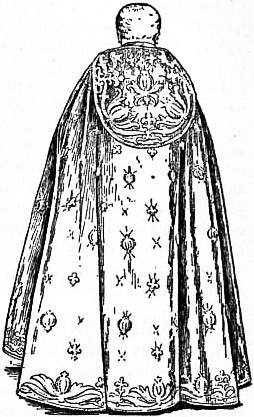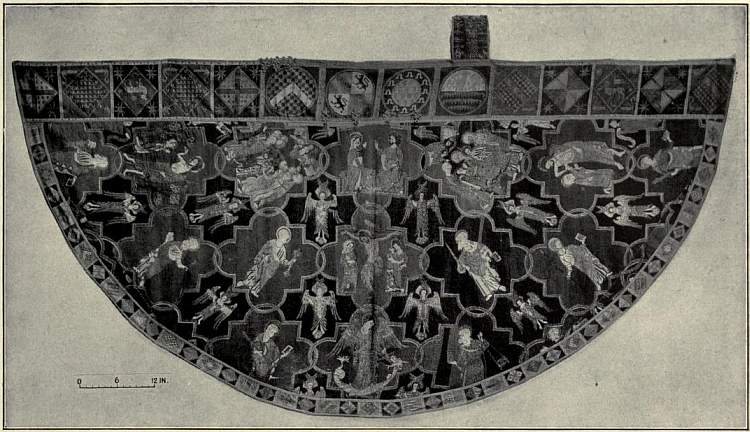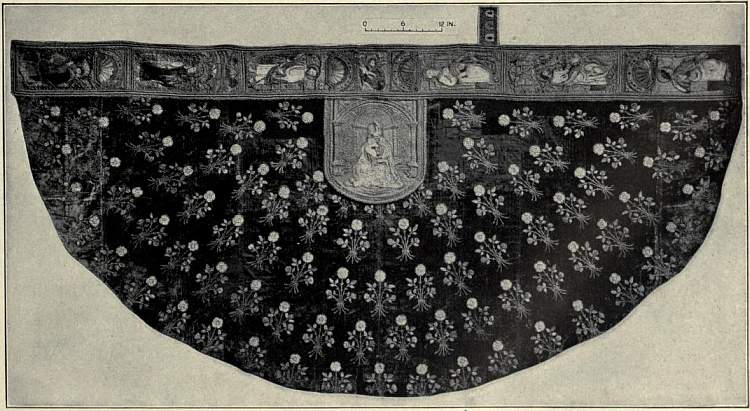COPE (M.E. cape, cope, from Med. Lat. capa, cappa), a liturgical vestment of the Western Church. The word “cope,” now confined to this sense, was in its origin identical with “cape” and “cap,” and was used until comparatively modern times also for an out-door cloak, whether worn by clergy or laity. This, indeed, was its original meaning, the cappa having been an outer garment common to men and women whether clerical or lay (see Du Cange, Glossarium, s.v.). The word pluviale (rain-cloak), which the cope bears in the Roman Church, is exactly parallel so far as change of meaning is concerned. In both words the etymology reveals the origin of the vestment, which is no more than a glorified survival of an article of clothing worn by all and sundry in ordinary life, the type of which survives, e.g. in the ample hooded cloak of Italian military officers. This origin is clearly traceable in the shape and details of the cope. When spread out this forms an almost complete semicircle. Along the straight edge there is usually a broad band, and at the neck is attached the “hood” (in Latin, the clypeus or shield), i.e. a shield-shaped piece of stuff which hangs down over the back. The vestment is secured in front by a broad tab sewn on to one side and fastening to the other with hooks, sometimes also by a brooch (called the morse, Lat. morsus). Sometimes the morse is attached as a mere ornament to the cross-piece. The cope thus preserves the essential shape of its secular original, and even the hood, though now a mere ornamental appendage, is a survival of an actual hood. The evolution of this latter into its present form was gradual; first the hood became too small for use, then it was transformed into a small triangular piece of stuff (13th century), which in its turn grew (14th and 15th centuries) into the shape of a shield (see Plate II., fig. 4), and this again, losing its pointed tip in the 17th century, expanded in the 18th into a flap which was sometimes enlarged so as to cover the whole back down to the waist. In its general effect, however, a cope now no longer suggests a “waterproof.” It is sometimes elaborately embroidered all over; more usually it is of some rich material, with the borders in front and the hood embroidered, while the morse has given occasion for some of the most beautiful examples of the goldsmith’s and jeweller’s craft (see Plate II., figs, 5, 6).
The use of the cope as a liturgical vestment can be traced to the end of the 8th century: a pluviale is mentioned in the foundation charter of the monastery of Obona in Spain. Before this the so-called cappa choralis, a black, bell-shaped, hooded vestment with no liturgical significance, had been worn by the secular and regular clergy at choir services, processions, &c. This was in its origin identical with the chasuble (q.v.), and if, as Father Braun seems to prove, the cope developed out of this, cope and chasuble have a common source.[1] Father Braun cites numerous inventories and the like to show that the cope (pluviale) was originally no more than a more elaborate cappa worn on high festivals or other ceremonial occasions, sometimes by the whole religious community, sometimes—if the stock were limited—by those, e.g. the cantors, &c., who were most conspicuous in the ceremony. In the 10th century, partly under the influence of the wealthy and splendour-loving community of Cluny, the use of the cope became very widespread; in the 11th century it was universally worn, though the rules for its ritual use had not yet been fixed. It was at this time, however, par excellence the vestment proper to the cantors, choirmaster and singers, whose duty it was to sing the invitatorium, responses, &c., at office, and the introitus, graduale, &c., at Mass. This use survived in the ritual of the pre-Reformation Church in England, and has been introduced in certain Anglican churches, e.g. St Mary Magdalen’s, Munster Square, in London.
By the beginning of the 13th century the liturgical use of the cope had become finally fixed, and the rules for this use included by Pope Pius V. in the Roman Missal and by Clement VIII. in the Pontificale and Caeremoniale were consequently not new, but in accordance with ancient and universal custom. The substitution of the cope for the chasuble in many of the functions for which the latter had been formerly used was primarily due to the comparative convenience of a vestment opened at the front, and so leaving the arms free. A natural conservatism preserved the chasuble, which by the 9th century had acquired a symbolical significance, as the vestment proper to the celebration of Mass; but the cope took its place in lesser functions, i.e. the censing of the altar during the Magnificat and at Mattins (whence the German name Rauchmantel, smoke-mantel), processions, solemn consecrations, and as the dress of bishops attending synods.
 |
| Fig. 1.—Seventeenth Century Coronation Cope at Westminster Abbey. |
It is clear from this that the cope, though a liturgical, was never a sacerdotal vestment. If it was worn by priests, it could also be worn by laymen, and it was never worn by priests in their sacerdotal, i.e. their sacrificial, capacity. For this reason it was not rejected with the “Mass vestments” by the English Church at the Reformation, in spite of the fact that it was in no ecclesiastical sense “primitive.” By the First Prayer-book of Edward VI., which represented a compromise, it was directed to be worn as an alternative to the “vestment” (i.e. chasuble) at the celebration of the Communion; this at least seems the plain meaning of the words “vestment or cope,” though they have been otherwise interpreted. In the Second Prayer-book vestment and cope alike disappear; but a cope was worn by the prelate who consecrated Archbishop Parker, and by the “gentlemen” as well as the priests of Queen Elizabeth’s chapel; and, finally, by the 24th canon (of 1603) a “decent cope” was prescribed for the “principal minister” at the celebration of Holy Communion in cathedral churches as well as for the “gospeller and epistler.” Except at royal coronations, however, the use of the cope, even in cathedrals, had practically ceased in England before the ritual revival of the 19th century restored its popularity. The disuse implied no doctrinal change; the main motive was that the stiff vestment, high in the neck, was incompatible with a full-bottomed wig. Scarlet copes with white fur hoods have been in continuous use on ceremonial occasions in the universities, and are worn by bishops at the opening of parliament.
With the liturgical cope may be classed the red mantle (mantum),
which from the 11th century to the close of the middle ages
formed, with the tiara, the special symbol of the papal
dignity. The immantatio was the solemn investiture
The
Papal
mantum.
of the new pope immediately after his election, by
means of the cappa rubea, with the papal powers.
This ceremony was of great importance. In the contested
election of 1159, for instance, though a majority of the cardinals
had elected Cardinal Roland (Alexander III.), the defeated
candidate Cardinal Octavian (Victor IV.), while his rival was
modestly hesitating to accept the honour, seized the pluviale
and put it on his own shoulders hastily, upside down; and it
was on this ground that the council of Pavia in 1160 based their
declaration in favour of Victor, and anathematized Alexander.
The immantatio fell out of use during the papal exile at Avignon
and was never restored.
It will be convenient here to note other vestments that have developed out of the cappa. The cappa choralis has already been mentioned; it survived as a choir vestment that in winter
took the place of the surplice, rochet or almuce. In the 12th
century it was provided with arms (cappa manicata),
The
cappa
magna.
but the use of this form was forbidden at choir services
and other liturgical functions. From the hood of the
cappa was developed the almuce (q.v.). At what
date the cappa choralis developed into the cappa magna, a
non-liturgical vestment peculiar to the pope, cardinals, bishops
and certain privileged prelates, is not known; but mention of it
is found as early as the 15th century. This vestment is a loose
robe, with a large hood (lined with fur in winter and red silk in
summer) and a long train, which is carried by a cleric called the
caudatarius. Its colour varies with the hierarchical rank of the
wearer:—red for cardinals, purple for bishops, &c.; or, if the
dignitary belong to a religious order, it follows the colour of the
habit of the order. The right to wear a violet cappa magna is
conceded by the popes to the chapters of certain important
cathedrals, but the train in this case is worn folded over the
left arm or tied under it. It may only be worn by them, moreover,
in their own church, or when the chapter appears elsewhere
in its corporate capacity.
Lastly, from the cappa is probably derived the mozzetta, a short cape with a miniature hood, fastened down the front with buttons. The name is derived from the Italian The mozzetta. mozzare, to cut off, and points to its being an abbreviated cappa, as the episcopal “apron” is a shortened cassock. It is worn over the rochet by the pope, cardinals, bishops and prelates, the colours varying as in the case of the cappa magna. Its use as confined to bishops can be traced to the 16th century.
See Joseph Braun, S. J., Die liturgische Gewandung (Freiburg im Breisgau, 1907); also the bibliography to the article Vestments. (W. A. P.)
 |
| Fig. 2.—THE SYON COPE. (English, 13th Century.) |
The medallions with which it is embroidered contain representations of Christ on the Cross, Christ and St Mary Magdalene, Christ and Thomas, the death of the Virgin, the burial and coronation of the Virgin, St Michael and the twelve Apostles. Of the latter, four survive only in tiny fragments. The spaces between the four rows of medallions are filled with six-winged cherubim. The ground-work of the vestment is green silk embroidery, that of the medallions red. The figures are worked in silver and gold thread and coloured silks. The lower border and the orphrey with coats of arms do not belong to the original cope and are of somewhat later date. The cope belonged to the convent of Syon near Isleworth, was taken to Portugal at the Reformation, brought back early in the 19th century to England by exiled nuns and given by them to the Earl of Shrewsbury. In 1864 it was bought by the South Kensington Museum.
 |
| Fig. 3.—COPE OF BLUE SILK VELVET, WITH APPLIQUÉ WORK AND EMBROIDERY. |
In the middle of the orphrey is a figure of Our Lord holding the orb in His left hand and with His right hand raised in benediction. To the right are figures of St Peter, St Bartholomew and St Ursula; and to the left, St Paul, St John the Evangelist and St Andrew. On the hood is a seated figure of the Virgin Mary holding the Infant Saviour. German: early 16th century. (In the Victoria and Albert Museum, No. 91. 1904.)
- ↑ This derivation, suggested also by Dr Legg (Archaeol. Journal, 51, p. 39, 1894), is rejected by the five bishops in their report to Convocation (1908). Their statement, however, that it is “pretty clear” that the cope is derived from the Roman lacerna or birrus is very much open to criticism. We do not even know what the appearance and form of the birrus were; and the question of the origin of the cope is not whether it was derived from any garment of the time of the Roman Empire, and if so from which, but what garment in use in the 8th and 9th centuries it represents.

